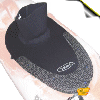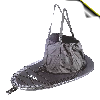Sealskin is a traditional material for spraydecks. It requires labor-intensive preparation. [3] A European description:
In fair weather the kaiak-man uses the so-called half-jacket (akuilisak). This is made of water-tight skin with the hair removed, and is sewn with sinews. Round its lower margin runs a draw-string, or rather a draw-thong, by means of which the edge of the jacket can be made to fit so closely to the edge of the kaiak-ring that it can only be pressed and down down over it with some little trouble. This done, the half-jacket forms, as it were, a water-tight extension of the kaiak. The upper part of the jacket comes close up to the armpits of the kaiak-man, and is supported by braces or straps, which pass over the shoulders and can be lengthened or shortened by means of handy runners or buckles of bone, so simple and yet so ingenious that we, with all our metal buckles and so forth, cannot equal them. Loose sleeves of skin are drawn up over the arms, and are lashed to the overarm and to the wrist, thus preventing the arm from becoming wet. Watertight mittens of skin are drawn over the hands. This half-jacket is enough to keep out the smaller waves which wash over the kaiak. In a heavier sea, on the other hand, a whole-jacket (tuilik) is used. This is made in the same way as the half-jacket, and, like it, fits close to the kayak-ring, but is longer above, has sleeves attached to it, and a hood that comes right over the head. It is laced tight around the face and wrists, so that with it on the kaiak-man can go right through the breakers and can capsize and right himself again, without getting wet and without letting a drop of water into the kaiak.
—Fridtjof Nansen, "Eskimo Life", 1893, English translation by William Archer









